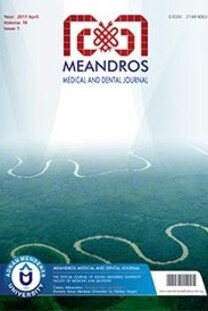Molecular Subtype Distribution and Cyclooxygenase-2 Expression Situation in Inflammatory Breast Cancer
Enflamatuvar Meme Kanserinde Moleküler Alt Tip Dağılımı ve Siklooksijenaz-2 Ekspresyon Durumu
___
- Lee BJ, Tannenbaum EN. Inflammatory carcinoma of the breast. Surg Gynecol Obstet 1924; 39: 580-95.
- Hance KW, Anderson WF, Devesa SS, Young HA, Levine PH. Trends in inflammatory breast carcinoma incidence and survival: the surveillance, epidemiology, and end results program at the National Cancer Institute. J Natl Cancer Inst 2005; 97: 966-75.
- Anderson WF, Schairer C, Chen BE, Hance KW, Levine PH. Epidemiology of inflammatory breast cancer (IBC). Breast Dis 2006; 22: 9-23.
- Kerlikowske K, Molinaro AM, Gauthier ML, Berman HK, Waldman F, Bennington J, et al. Biomarker expression and risk of subsequent tumors after initial ductal carcinoma in situ diagnosis. J Natl Cancer Inst 2010; 102: 627-37.
- Van Laere SJ, Van den Eynden GG, Van der Auwera I, Vandenberghe M, van Dam P, Van Marck EA, et al. Identification of cell-of-origin breast tumor subtypes in inflammatory breast cancer by gene expression profiling. Breast Cancer Res Treat 2006; 95: 243-55.
- Kertmen N, Babacan T, Keskin O, Solak M, Sarici F, Akin S, et al. Molecular subtypes in patients with inflammatory breast cancer; a single center experience. J BUON 2015; 20: 35-9.
- Denkert C, Winzer KJ, Müller BM, Weichert W, Pest S, Köbel M, et al. Elevated expression of cyclooxygenase-2 is a negative prognostic factor for disease-free survival and overall survival in patients with breast carcinoma. Cancer 2003; 97: 2978-87.
- Half E, Tang XM, Gwyn K, Sahin A, Wathen K, Sinicrope FA. Cyclooxygenase-2 expression in human breast cancers and adjacent ductal carcinoma in situ. Cancer Res 2002; 62: 1676-81.
- Glover JA, Hughes CM, Cantwell MM, Murray LJ. A systematic review to establish the frequency of cyclooxygenase-2 expression in normal breast epithelium, ductal carcinoma in situ, microinvasive carcinoma of the breast and invasive breast cancer. Br J Cancer 2011; 105: 13-7.
- Friedman GD, Ury HK. Initial screening for carcinogenicity of commonly used drugs. J Natl Cancer Inst 1980; 65: 723-33.
- Ashok V, Dash C, Rohan TE, Sprafka JM, Terry PD. Selective cyclooxygenase-2 (COX-2) inhibitors and breast cancer risk. Breast 2011; 20: 66-70.
- Subbaramaiah K, Hart JC, Norton L, Dannenberg AJ. Microtubule-interfering agents stimulate the transcription of cyclooxygenase-2. Evidence for involvement of ERK1/2 AND p38 mitogen-activated protein kinase pathways. J Biol Chem 2000; 275: 14838-45.
- Falandry C, Canney PA, Freyer G, Dirix LY. Role of combination therapy with aromatase and cyclooxygenase-2 inhibitors in patients with metastatic breast cancer. Ann Oncol 2009; 20: 615- 20.
- Arun B, Goss P. The role of COX-2 inhibition in breast cancer treatment and prevention. Semin Oncol 2004; 31(2 Suppl 7): 22- 9.
- ISSN: 2149-9063
- Yayın Aralığı: 4
- Başlangıç: 2000
- Yayıncı: Aydın Adnan Menderes Üniversitesi
Wellens Sendromu: Kritik Sol Ön İnen Koroner Arter Darlığı
Nuri KÖSE, Fatih AKIN, İbrahim ALTUN
The Happy End of Tragic Story: Recycling of Avulsed Teeth
Zuhal KIRZIOĞLU, K. Görkem ULU GÜZEL, HÜSEYİN KARAYILMAZ, MEHMET MUSTAFA ÖZARSLAN, MEHMET ALİ ALTAY
Is Lumbo-Sacral Angle Related to Plantar Loading Patterns in Patients with Ankylosing Spondylitis?
ELİF AYDIN, Yasemin DURUM, İMRAN KURT ÖMÜRLÜ, Yasemin TURAN, Pelin YILDIRIM
NİHAL ÖZCAN, Merve ERKMAN ALMAZ, Işıl ŞAROĞLU SÖNMEZ, Emre BARIŞ
Ortodontik Diş Hareketini Etkileyen Endojen ve Eksojen Maddeler
MİNE GEÇGELEN CESUR, Gözde BEYGİRCİ
Clinical Characteristics of Fungal Sensitization in Children with Allergic Respiratory Diseases
Pınar UYSAL, DUYGU ERGE, Ayşe YENİGÜN
Pusem PATIR, Burçak KARACA, Alper ŞENER, Osman ZEKİOĞLU, Güray SAYDAM, Canfeza SEZGİN
Mutlu ÇOBANOĞLU, Özgür ÖZBEY, Öner ŞAVK, Ferit ÖZGEZMEZ
The Role of Neurosurgeons in Neurointerventional Surgery
Ali YILMAZ, Mücahit AVCİL, AYÇA ÖZKUL, ABDULLAH TOPCU, Bayram ÇIRAK, Feridun ACAR, Erdal COŞKUN
Ön Kamaraya Yüksek Doz Sefuroksim Verilmesi Sonucu Oküler Toksisite
HARUN ÇAKMAK, Mehmet ÖZBAĞCIVAN, Tolga KOCATÜRK, Sema ORUÇ DÜNDAR
